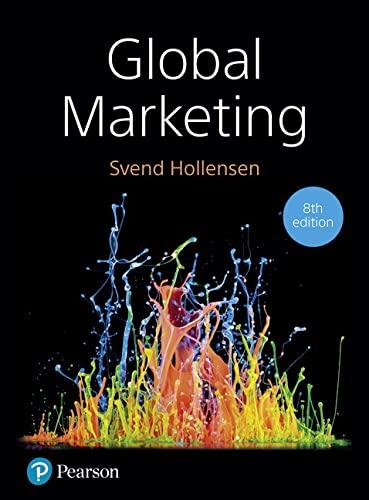Harley-Davidsons mission statement is: We fulfil dreams through the experience of motorcycling. History The Harley-Davidson Motorcycle Company
Question:

Harley-Davidson’s mission statement is: ‘We fulfil dreams through the experience of motorcycling’.
History
The Harley-Davidson Motorcycle Company (www. harley-davidson.com) was founded in 1903. Harley- Davidson (H-D) soon became the world’s leading manufacturer of motorcycles, based on a reputation of quality and reliability. After World War II, and the demise of the American Indian motorcycle, Harley-
Davidson became the sole US manufacturer of motorcycles. In 1969, Harley-Davidson was sold to American Machine and Foundry (AMF).
AMF almost tripled production to 75,000 units annually over a four-year period to meet the increase in demand. Unfortunately, product quality deteriorated significantly as over half the motorcycles that came off the assembly line had parts missing and dealers had to repair them in order to make sales.
Little money was invested in improving design or engineering. The motorcycles leaked oil, vibrated and could not match the excellent performance of the Japanese products.
During this time, Honda was beginning to penetrate the American motorcycle market and gain a significant market share. Honda manufacturing plants incorporated the principles of total quality management (TQM). Honda began producing motorcycles with constantly improving quality at a time when the quality of Harley-Davidson was drastically decreasing. By the early 1980s Honda almost totally dominated the world motorcycle market.
Japanese manufacturers also moved into the heavyweight motorcycle market and began selling Harley look-alike motorcycles. Yamaha was the first company to do so, and was soon followed by the three other major Japanese manufacturers – Honda, Suzuki and Kawasaki. Their products looked so similar to Harley-Davidson’s that it was difficult to tell the difference without reading the name on the petrol tank. The Japanese companies also copied the style of the Harley-Davidson advertisements.
Since then the Harley-Davidson (HD) Corporation has dominated the motorcycle industry for many decades. Today, it continues to have a strong presence in the world market for heavyweight cruisers. In the financial year 2017, the net revenues of HD were US$5.6 billion. In 2017 HD had 1,400 dealers selling 242,000 HD motorcycles worldwide and employed about 5,800 people worldwide. In the heavyweight section (651+ cc) HD is a clear market leader in North America with a 55 per cent market share. Its market share in Europe is 12 per cent. The mission statement of the company is to fulfil dreams through the experience of motor-cycling, by providing to the motorcyclists and the general public an expanding line of motorcycles, and branded products and services, in selected market segments. HD offers a complete range of motorcycles, parts, accessories, apparel and general merchandise. Strategic licensing of the HD brand helps create future generations of Harley-Davidson enthusiasts.
HD celebrated its 100-year anniversary in 2003.
Over the previous century the company managed to create a strong brand image and a loyal customer base within the marketplace. Much of the value of a Harley resides in its tradition – the look, sound and heritage that have made it an all-American symbol.
The bikes represent something very basic – a desire for freedom, adventure and individualism.
HD maintains a close relationship with its customers through a variety of programmes (Harley Owners’ Group), product offerings and events such as the Daytona bike week, motor shows and rallies.
However, the company is facing rigorous competition from Japanese manufacturers, specifically Honda and Yamaha. HD’s strength is its brand image within the marketplace, but its weakness is related to production capacity and unfulfilled demand for its products. HD tries to continue to strengthen its positioning strategy by building on the ‘Own an American Icon’ slogan.
As its average customer’s age rises, and sales go down, HD faces the task of attracting younger customers. Part of retooling its image included releasing a new motorcycle, the Buell, designed for young professionals.
According to the Motorcycle Industry Council (www.mic.org), an industry trade group based in Irvine, California, the women’s market accounts for about 11 per cent of the total motorcycling population.
Pricing
The international price competition is getting tougher. Compared with similar models from Honda, HD still has a 30 per cent price premium; even though Harley bikers still wear T-shirts saying ‘I’d rather push a Harley than drive a Honda’.
Today, HD’s sales of motorcycles outside the US comprise around 25 per cent of its annual total.
Europeans like cruiser bikes, but they are not so keen on Harley prices. In 2011, the European market share of HD in the heavyweight segment (over 650 cc) was around 12 per cent. The 2011 market leaders in Europe were Honda, Yamaha, Suzuki and BMW, each with around 15 per cent market share.
On 15 October 2009, Harley-Davidson Inc.
announced the end of production of Buell Motorcycles to focus more on the HD brand.....
Questions
1. Describe Harley-Davidson’s general pricing strategy.
What does the company’s positioning have to do with its pricing strategy?
2. Should Harley-Davidson alter its price, given that there are strong price pressures from rivals?
3. What should Harley-Davidson do to improve its market share in Europe – given the new EU tariffs?
Has the HD made the right decision to move production to new international facilities?
Step by Step Answer:






